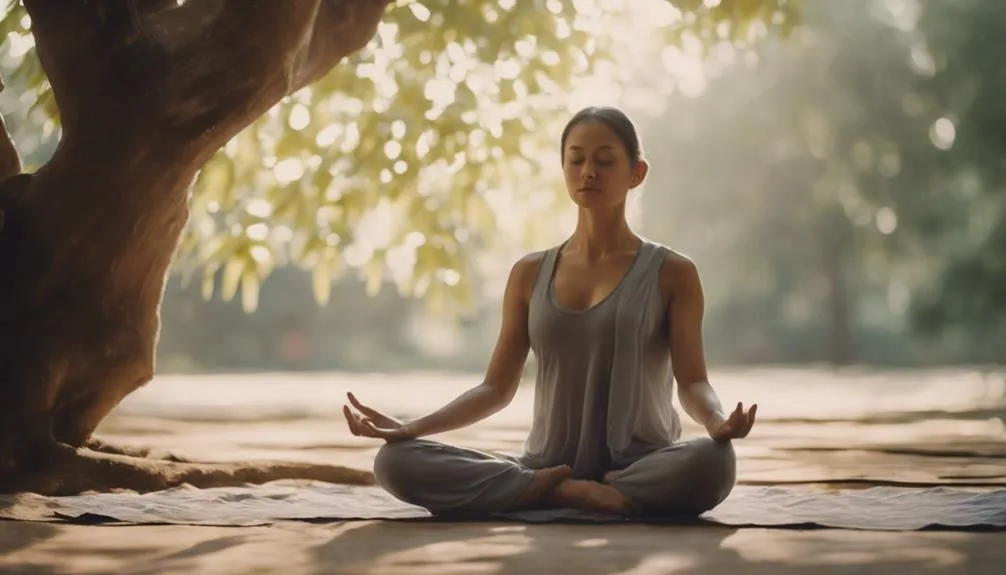Mastering the Buddha's Meditation Posture for Deepened Practice
Like a tree firmly rooted in the earth, mastering the Buddha's meditation posture can ground your practice, allowing you to reach new heights of mindfulness and concentration. By aligning your body in this historically significant stance, you're not only honoring a tradition but also unlocking a deeper connection with your inner self.
You might wonder how such a simple adjustment can lead to profound changes in your meditation experience. The answer lies in the subtleties of this practice, which we'll explore together, offering you a path to discover the transformative power of proper posture.
Are you ready to elevate your practice?
Key Takeaways
- Correct posture aligns physical and energetic bodies, enhancing meditation stability, comfort, and focus.
- Mindful alignment of the spine supports optimal breathing, promoting relaxation and mental clarity.
- Adjusting posture to avoid common mistakes like slouching ensures a strong foundation for practice and energy flow.
- Mastering the Vairocana posture connects practitioners with Buddhist tradition, deepening spiritual practice and enlightenment.
The Importance of Posture
Mastering the correct posture isn't just about physical alignment; it's a profound gesture of respect towards your inner self and the ancient wisdom of Buddhist meditation. When you engage in meditation practice, you're not just sitting; you're aligning your physical and energetic bodies in a way that promotes stability and comfort. This alignment isn't merely for the sake of physical health; it's a vibrant symbol of inner balance and harmony.
By adopting the Vairocana posture, you embrace a tradition that enhances relaxation, mental clarity, and inner strength. This posture, with its historical significance, connects you directly to the cosmic Buddha Vairocana, embodying enlightenment and wisdom within your practice. It's a reminder that every aspect of your meditation techniques, from the way you sit to the placement of your hands, is imbued with meaning and purpose.
Understanding the importance of posture in your meditation practice is the first step towards deepening your connection to the practice. It supports mindfulness, concentration, and proper breathing, setting a solid foundation for your journey inward. Respect for this tradition isn't just about the physical form but honoring the profound connection between body and mind.
Aligning the Body Mindfully
Aligning your body mindfully during meditation serves as the bridge between the physical and spiritual realms, fostering a profound sense of inner peace and harmony. The Buddha's meditation posture, particularly the Vairocana, is designed to enhance this connection. Through mindful alignment, you not only ensure physical benefits but also pave the way for inner balance and spiritual growth.
| Aspect | Benefit | Connection to Practice |
|---|---|---|
| Mindful Alignment | Enhances stability and comfort | Facilitates deeper meditation |
| Inner Balance | Promotes relaxation, spinal health | Symbolizes harmony |
| Posture Awareness | Leads to mental clarity | Aids in spiritual practice |
Understanding how each aspect of your posture connects to your meditation practice illuminates the path to mastering it. Mindful alignment ensures that you're not just sitting but participating in a profound spiritual exercise. As you align your body, you're not merely adjusting your physical form; you're recalibrating your spiritual compass. This practice, steeped in the wisdom of the Buddha, offers more than just physical benefits—it's a gateway to deeper understanding and inner strength. Remember, every adjustment in posture is a step towards greater mental clarity and spiritual growth.
Breath and Posture Connection

Understanding the symbiotic relationship between breath and posture is crucial for deepening your meditation practice. When you sit to meditate, aligning your spine isn't just about maintaining a traditional posture; it's about creating the conditions for your breath to flow freely. This harmonious alignment fosters optimal breathing patterns, which are essential for achieving a state of relaxation and focus. As you improve your alignment, you'll notice your awareness of the breath intensifies, allowing you to become more present and mindful.
Proper posture supports unrestricted diaphragmatic breathing, enabling you to draw deeper, more nourishing breaths. This not only enhances your physical well-being but also strengthens the mind-body connection, grounding you in the present moment. By consciously adjusting your posture to deepen your breath, you're not just sitting; you're actively engaging in a practice that enhances awareness and fosters a deeper connection to your meditation.
The integration of breath and posture is more than a physical act; it's a profound practice that enriches your meditation, deepening your practice and enhancing your awareness. Embrace this connection, and watch as your meditation practice transforms, bringing you closer to a state of harmony and mindfulness.
Common Posture Mistakes
While embarking on your meditation journey, it's crucial to be mindful of common posture mistakes that can hinder your progress and comfort. Correcting these errors not only enhances your physical ease but deepens your meditation practice, allowing you to connect more profoundly with your inner self.
- Correcting slouching, hunching: Maintaining a straight, yet relaxed, back prevents discomfort and instability, fostering a stronger meditation foundation.
- Hand placement awareness: Be mindful of keeping your hands gently rested, avoiding tensing or gripping, to facilitate relaxation and proper energy flow.
- Spine alignment benefits: Aligning your spine straight and relaxed promotes energy flow throughout your body, minimizing strain and enhancing your meditative state.
- Shoulder relaxation: Keeping your shoulders relaxed and open is key to avoiding tension that can restrict breathing and impact your meditation experience.
- Chin position: Slightly tucking in your chin helps in reducing neck tension and maintaining the alignment of your head and spine, crucial for a focused and effective practice.
Enhancing Meditation Through Posture

Recognizing and correcting common posture mistakes sets a strong foundation, but mastering the Vairocana posture can profoundly elevate your meditation experience. This stance, deeply rooted in ancient Buddhist traditions, isn't just a physical position; it's a gateway to deeper spiritual alignment. By adopting this posture, you connect with centuries of spiritual practice, enhancing not just your physical well-being but also your spiritual journey.
The benefits of a proper posture extend beyond the immediate calmness and relaxation you feel. It improves spinal health, leading to better overall posture even outside meditation sessions. This alignment fosters a stronger mind-body connection, making you more aware of the subtle shifts within your being. You'll notice a clearer mind and an inner strength that perhaps was elusive before.
Spiritual alignment, a core aspect of the Vairocana posture, binds you to your spiritual roots. This connection is more than symbolic; it's a physical embodiment of your dedication to your practice. As you sit in this posture, remember you're not just seeking mental clarity but also a profound spiritual awakening. Let each breath deepen your connection, guiding you toward a more enlightened state.
Frequently Asked Questions
What Is the Posture for Meditation in Buddhism?
In Buddhism, your meditation posture involves sitting cross-legged with varied leg positions, emphasizing breath focus and cushion support for comfort. Ensure a straight, relaxed spine and open shoulders for deeper mindfulness and spiritual connection.
What Is the Most Powerful Buddhist Meditation?
Vipassana meditation is the ultimate game-changer among Buddhist practices. It elevates mindfulness practices, integrates Zen koans, and embraces loving kindness meditation, offering unparalleled insight and liberation. You'll find it transformative in understanding reality's profound nature.
How Do You Train Posture for Meditation?
To train your posture for meditation, focus on body alignment, ensuring your spine's straight and shoulders relaxed. Make comfort adjustments as needed, and practice breath control to deepen your focus and mindfulness.
What Technique of Meditation Did Buddha Use?
Buddha used the Anapanasati technique, focusing on breath to enter Dhyana states. This mindfulness focus cultivates deep awareness, bringing you closer to enlightenment. It's about observing the present, embracing tranquility without clinging to fleeting thoughts.
Conclusion
In mastering the Buddha's meditation posture, you're not just sitting; you're embodying mindfulness, aligning your body and breath, and embracing inner harmony.
By avoiding common posture mistakes, you align more than just your spine; you align your spirit. This isn't merely about sitting straight; it's about reaching deep within, finding balance, and unlocking a profound connection to the cosmos.
Embrace this ancient posture; let it guide you to clarity, strength, and spiritual awakening. Remember, in stillness, you find movement; in posture, you discover freedom.






